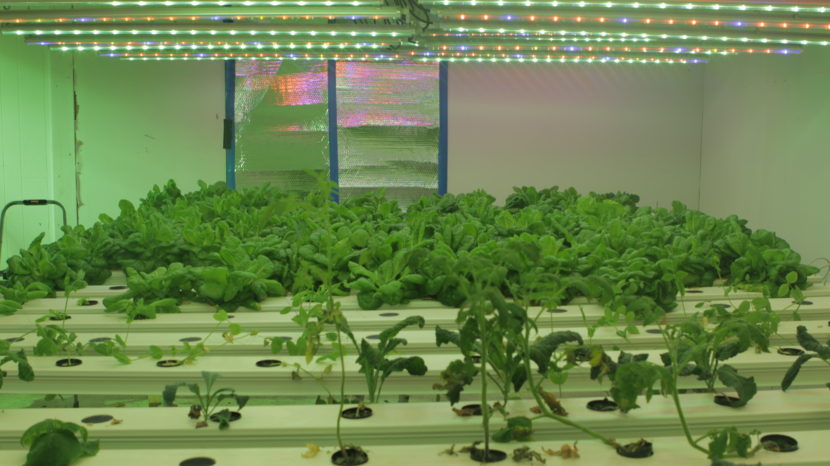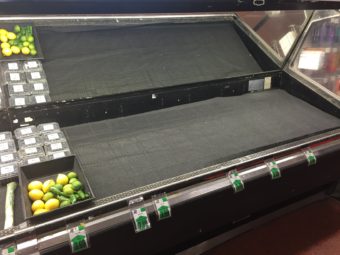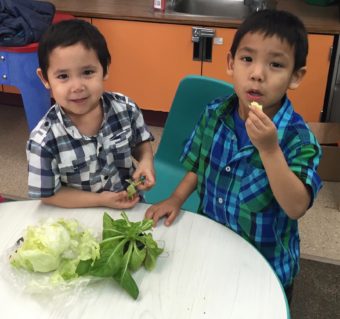
St. Paul’s greenhouse isn’t what you’d imagine. There’s no big glass structure. All the windows are covered from the inside. It’s underneath the city’s grocery store on the first floor of the building.
It’s hydroponic. Blue and red LED lights hang suspended above the plants. Pumps fill the room with white noise.
“Let’s try to find a big one,” greenhouse manager Dallas Roberts said.
He dropped by on a recent afternoon to harvest six heads of lettuce.
“These have been growing for close to a month or month and a half,” Rpberts said. “They’re fantastic.”
The 19-year-old grew up on the island. He said the availability of fresh produce is a big deal in St. Paul. There’s only one shelf for it at the grocery store.

Lauren Divine is the co-director of the tribe’s Environmental Conservation Office (ECO). She said problems with cargo shipping mean that by the time vegetables hit the shelves, they’re already rotten.
“We ran out of carrots, potatoes, and onions,” Divine said. “Those are cold-cellar, long-storage type vegetables. They were spoiling and going bad. The store had to throw them away.”
St. Paul’s greenhouse was built with more than $400,000 in federal grant money. The goal is to produce high-quality, affordable food for the community. At first, the idea was to build a traditional all-glass greenhouse.
But when Divine joined the project, she scrapped those plans because she didn’t think it was sustainable.
A box greenhouse kit would have to be barged in and because St. Paul is volcanic, the same would be true for fertilizer and topsoil.
“It took a lot to change everyone’s minds from thinking they would see this glass building to coming into a hydroponics operation and seeing the lettuce grow without soil in this very different, almost alien way,” Divine said.
The cost of running the hydroponic greenhouse is so low that they’re giving away the produce. The electric and water costs are covered by the Aleut Community of St. Paul tribal government.
Plants can grow inside the greenhouse year-round. Right now, they’re producing about 60 heads of lettuce a week. Plus, there’s tomatoes, cucumbers, peppers, cilantro, and more. There’s even an outdoor garden with potatoes and kale.

Divine said kids are some of the biggest advocates for the greenhouse. They even ask their parents to get lettuce.
“When you can sit down and have a meal with rutabaga, seal, potatoes, and carrots — all coming from St. Paul — it really shifts their view of subsistence. It can be all the food that we grow,” Divine said. “I can grow this at my house, or I can come down to the garden and harvest it. It’s from here and it’s our food.”
But there have been problems. The heat in the greenhouse is provided by the grocery store above. When the business adjusts the temperature, it can kill the crops.
Still, demand for the produce is so strong that Divine plans to expand. She has her eyes on a new warehouse space that could fit a greenhouse twice the size of the current one. That may allow ECO to sell extra produce to Trident — the local fish processing plant — for its salad bar.
For now, the greenhouse staff gives away the vegetables. They can donate to the food bank and share with elders.
Remember those six heads of lettuce Dallas Roberts cut? A few minutes after he harvests them, he delivers them to the local tavern.
“It’s the best that we’ve got,” Roberts said.
The cooks will use the lettuce for tomorrow’s dinner: Indian tacos.
Zoe Sobel is a reporter with Alaska's Energy Desk based in Unalaska. As a high schooler in Portland, Maine, Zoë Sobel got her first taste of public radio at NPR’s easternmost station. From there, she moved to Boston where she studied at Wellesley College and worked at WBUR, covering sports for Only A Game and the trial of convicted Boston Marathon bomber Dzhokhar Tsarnaev.




